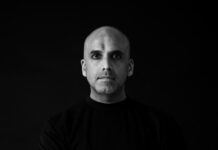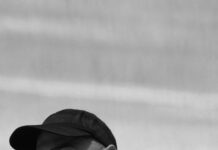Foto: Peter Vulchev (KiNK)
In addition to our extensive KiNK cover story in the latest Groove issue, the producer whose Playground LP has just been released through Gerd Janson’s Running Back sat down to answer the questions submitted by our readers. Here’s KiNK’s Ask The DJ special – or rather, Ask The Artist.
What was the first piece of gear you were working on and do you still use it?
It’s hard for me to define what was my first piece of gear, because I liked to play around with sound since an early age and I would consider any electrical tool in our flat as a music instrument. But I’ll share with you a story about the first instrument I personally chose and bought, with the idea to produce Techno. It was around 1994, when I knew I want a synthesizer. My dad gave me a small amount of money and I started looking around for a synthesizer at second-hand stores. There was no big choice in Bulgaria at that time and also no any information. I found an extremely cheap Russian keyboard, called Polivoks. I was interested in it only because of the price tag, but I didn’t buy it, because it didn’t look Techno enough to me. I expected a more modern and digital look, screens and light diodes. That Russian synth looked old. I spent all the money on a more expensive Casio Rompler instead, with preset sounds, rhythms and built in speakers. It had a lot of blinking lights and on the front panel it said “techno beat, samba, disco”. Very quickly I figured out I made a big mistake, I bought a toy. I went back to look for that Russian synth. The guy at the shop told me he just sold it to some guys from a church, who were looking for a very cheap instrument, which can be used as an organ. The seller said the guys were trying to achieve an organ sound for many hours, but this beast was doing only insane alien sounds. They still ended up buying it, because it was the only thing they could afford. It was exactly what I wanted, but it was too late. I sold that Casio with little profit. The next synth I managed to buy was a Vermona Synthesizer, we bought it with my good friend Konstantin “KEi” in 1998 from the same shop. We still have it and we abused it a lot through the years, it`s in the basement now, waiting for repair. KEi bought a second one recently in a better condition, it’s in my studio and once in a while we jam with it, remembering of the old times.
What do you listen to at home or when you’re traveling?
Unfortunately right now I don’t have much time to listen to other people’s music properly because I rarely do DJ sets nowadays and in my free time I’m mostly troubleshooting my live setup, producing music, learning new gear i buy or looking for new ways to make sounds. I’m always behind schedule with all that and I don’t get enough time to sleep, so I had to sacrifice something. I get my portion of interesting music by following DJs I like. My good friend Phil Banks from Plymouth is playing a mixture of very odd electro and acid music, I love to listen to his mixes. Another friend of mine, Olivier, also known as Mush, who runs the Sharivari label and Chez Emile record store always posts great music on his Facebook page and I check his page all the time. You can find a lot of forgotten old stuff and weird fresh records there, always very funky. Olivier can’t go wrong! I’m also following the Macro crew, they always offer music, which is edgy and different. Finn Johannsen is putting out interesting mixes once in a while and Stefan Goldmann – my only chance to listen to him is when we play together, luckily it happens once in a while. I’m also spending a lot of time, listening to synthesizer demos on YouTube, my favorite channels are those by Mootbooxle and Djangosfire. Moot is playing funk/soul music on his keyboards and talking about his gear and music with such a passion, it’s infectious! Djangosfire is all about west coast synthesis and DIY scene, Really abstract stuff, Morton Subotnick on steroids! On my phone I have only two records right now, Arrange and Process Basic Channel Tracks (by Scion) on Tresor and Elseq 1-5 by Autechre.
More and more house/techno live acts play solo-shows in concerts rather than at partys, such as Bicep or Kiasmos. Is this something you would consider yourself? Why or why not?
It’s a direction which was not interesting for me in terms of fun, because I was never into bands. I was into dance music and dancing since I can remember. From Disco to Techno and House. I love being in clubs. I love the DJ culture. Raw basements, sweaty dancefloors and people dancing like no one is watching. The concerts with big production involved were never interesting to me, but I’ve learnt that i should never say never, because I also didn’t liked the idea of electronic music live performances versus DJing and now that’s what I do every weekend, playing live, for the past 9 years. I’m still not considering to swap the warehouse with the concert hall, but throughout the years I became more open about every form of expression and there will be a time, when I’ll have the right content for it, audio, visuals or both. I played before Bicep last weekend in Manchester and they were amazing. Amon Tobin’s Isam show is quite impressive, at least judging from the videos I’ve seen online. Once I have something to say – I will do it. And I’m sure that day will come.
Do you ever think about if or how you can perform a track live when you work on it? Or do you ever feel the urge to produce a “crowdpleaser” or are frustrated that you can’t play out some of your more experimental tracks?
I don’t think how I can play a track while I’m producing it, but playing live influenced the way I make music in the studio. It used to be a very cold and mathematical process, but during the past few years I moved towards jamming in the studio and recording. Still I find both processes very different and I’m happy to keep them like that. When I produce music, for me it’s all about diving deep into sound, having all the time in the world to explore and learn. Playing live – for me it’s the opposite: I’m having a Kung-Fu fight and my main opponent is the time. I have only few hours on a stage, in a country to which I might not return soon. I’m trying to compress what I’m doing in the studio for weeks into few hours. The higher level of difficulty I set – the bigger adrenalin rush and satisfaction I get, Those are two different ways of getting naturally high on music. Yes, I feel the urge to produce a crowdpleaser. I like simple catchy tracks as much as I like music which has more deeper meaning. I play the music I would like to listen to in a club. A crowdpleaser in my set would help me to win the crowd on my side, so I can be more experimental when I feel like doing it. What frustrates me is when I’m criticized for being too functional and predictable with my crowdpleasers, while my abstract stuff and new experiments often stay unnoticed by the same critics. However, I try to look at it from a positive side, right or wrong, it can only help me to improve my Kung-Fu.
At ADE you recently performed together with Henrik Schwarz. How much did you have to rehearse and what interests you in live collaborations such as this?
We had a phone chat for few minutes in the beginning of the year. I asked Henrik, “shall we do it?”, and he said “Yes, let’s do it”. We agreed on few points, like using our usual setups, doing a fully improvised set and synchronizing our tempos rather by ear instead of having any automatic connection. We had this phone call many months before the show, I was planning to come and meet Henrik in Berlin, but it never happened, so our only rehearsal was that five minute call. Also we had a proper soundcheck together, at the night before the gig. We just plugged our setups and jammed for an hour without talking. Later that night we played. I think it was great. One of us asked, “Shall we do it again?”, the other said “Yes”. Working with people has been a serious school for me. Henrik is one of the best electronic music artists of our time. His sounds and approach to playing music is very different from mine and I thought it would be interesting for both of us to exchange our experiences. So far it has been great and I’m looking forward to the next time.
What’s the difference between your Cyrillic project and what you do under the name of KiNK?
KiNK is very diverse in terms of musical variety and performance, and it’s based on the KiNK records. A KiNK live set involves many types of gear, digital, analog, DJ equipment. As KiNK, I’m engaging the crowd a lot. Cyrillic the opposite. Musically and performance wise it’s very limited and stripped down. The idea behind it is to play a completely improvised live set, using a standard DJ setup. I’ve built a library of very basic and short loops, all recorded with my modular synthesizer. I play them from 3 CDJs. All the rhythms are coming from the Roland TR-8 drum machine. In order to make one track, I have to play a combination of loops, at least from two CDJs and to make the beats live from the TR-8. All mixed by ear, no automatic sync. None of the music I play exists. Sometimes I bring an additional synthesizer, but usually the setup is a TR-8, 3 decks and a mixer. It’s a very intense performance, making music out of very basic content. Compared to KiNK I have less time to interact with the crowd as Cyrillic and I’m twice more sweaty when I finish the set. The music is pure techno. Very spontaneous and full of surprises, but also very repetitive, unlike KiNK. In 2018 I will start releasing music with this new project and I will change the spelling of the name as Kirilik, so stay tuned.
Are there any young artists that inspire you (not only musically)?
Andrew Morrison, a young man, who is doing medical researches during the day and amazing music in his free time, releasing it as The Cyclist, and Buz Ludzha. He is programming his own software tools and using cheap hardware in a weird way. I love his sound and the way he is doing it. Also my friends Peter-Jan and Robin, who run a company, called OWOW in The Netherlands. They are producing unusual music instruments, which I use a lot in my live sets. Another very talented friend of mine, who I rediscovered recently is Yana Krachunova. She describes herself as a “Visual Optimist” on her social media pages. She dealt with everything, from traditional painting and static images to experimental digital video art and I really like her work. You can see she has the skills, shaped by the traditional school, but her output is new and surprising, regardless the format she is dealing with.





